Pronoun | What does pronoun mean? Different Types of Pronouns with 60+ Perfect Examples
How to be more confident in your pronoun usage. It’s easy to get a little shy in the presence of people who know you so well. But it’s often unsettling when even you don’t know quite how to use your pronoun correctly in conversations. In this post, we’ll look at how you can become more confident in your pronoun usage.
What does pronoun mean?
A pronoun is a word used instead of a noun. The word ‘pronoun’ also means ‘for a noun’. It is used for a noun. So, it is called a ‘pronoun’. It is used to avoid the repetition of the noun.
Examples
I, we, he, she, they, that, this, these, those, each, every, are called pronouns.
When we talk about some person, place, or thing, we mention it by its name. If we have to mention it again and again, it looks odd to use its name every time. For example,
Karachi is the biggest city of Pakistan. Karachi is the remote area of Sindh Province. Karachi is a very populous city.
In the above sentence, we have used the word ‘Karachi’ again and again. It does not seem appropriate to repeat this word again and again. It is better to avoid the repetition of noun Karachi and say:
Karachi is the biggest city of Pakistan. It is the remote area of Sindh Province. It is a very populous city.
Now, the use of an appropriate ‘pronoun’ in place of a noun has made the passage beautiful, comprehensive, and interesting.
It is important to discuss here that the original noun that the pronoun replaces is called the antecedent of the pronoun. Pronoun has three qualities.
- Person
- Number
- Gender
While using a pronoun we must take care that it must agree with its antecedent in all three elements. For example, in the abovementioned paragraph, we used ‘it’ for ‘Karachi’ keeping in mind the person, number, and gender of the noun.
Read also: Pronoun Examples | 50 Sentences
Types of Pronouns
- Personal Pronoun
- Possessive Pronoun
- Interrogative Pronoun
- Relative Pronoun
- Distributive Pronoun
- Demonstrative Pronoun
- Reflexive Pronoun
- Indefinite Pronoun
- Emphatic Pronoun
- Exclamatory Pronoun
- Quantifier Pronoun
- Reciprocal Pronoun
1 – Personal Pronoun
A personal pronoun is used instead of a person’s name. It is used for the common or proper noun.
Examples
I, we, you, he, she, they, it
Personal pronoun has three forms
1.1 – Nominative or subjective form
- He plays cricket.
- I took tea.
In the above sentences, ‘He’ and ‘I’ are subjective forms of pronoun.
1.2 – Objective form
In this form, pronoun is used as object.
Example
Aslam punished me.
1.3 – Possessive case
In this case, pronoun is used to indicate the person, thing, possession or link.
Examples
- Your book
- My pen
- His house
Further Reading: Personal Pronouns [Chart, Examples & 5 Types]
2 – Possessive Pronoun
A pronoun indicating possession or ownership in a sentence is called possessive pronoun. There is some misconception which people do while using possessive pronouns usually, his, their, her, its, your, my and our, are considered as possessive pronouns, however, these are possessive adjectives.
The correct possessive pronouns are his, hers, theirs, mine, ours, yours, its, etc.
Examples
- I did not have my pen to write, so Jimmy lent me his pen. (incorrect)
- I did not have my pen to write, so Jimmy lent me his. (correct)
- Your dress is not as beautiful as my dress. (incorrect)
- Your dress is not as beautiful as mine. (correct)
- Those are my supporters. They are not your supporters. (incorrect)
- Those are my supporters. They are not yours. (correct)
To understand the possessive pronouns, see the following table.
| Subject Pronoun | Possessive (absolute) | Possessive (adjective) |
| I | Mine | My |
| He | His | His |
| You | Yours | Your |
| It | Its | Its |
| She | Hers | Her |
| They | Theirs | Their |
3 – Interrogative Pronoun
It is used to ask questions interrogative pronoun is explained through noun. The interrogative pronouns are who, whom, what, which and whose.
Examples
- What is your name?
- Where are you going?
- Whose house is that?
- Why are you weeping?
- Whom did they invite?
Remember: “That” and “whose” are used for all living and non-living things. “Which” is used for animals and non-living things. “Who” and “whom” are used only for men.
In some cases, interrogative pronouns are used in suffix-ever
Examples
- Whoever
- Whatever
- Whichever
- Whosever
At the end of sentences containing interrogative pronouns, we use a question mark.
- When will you go to Murree?
- Whose book is this?
- Which bat do you use to play cricket?
4 – Relative Pronoun
Relative pronoun does the work of conjunction as well as a pronoun. It introduces a clause.
- I met a man.
- The man is my neighbor.
When we write the above two sentences together, we use ‘and’.
I met a man and he is my neighbor.
We can connect these sentences by the use of “who” also.
I met a man who is my neighbor.
4.1 – List of Relative Pronouns
- As
- But
- How
- That
- What
- When
- Which
- Whom
- Whose
4.2 – Forms of Relative Pronouns
| – | Subject | Object | Possessive |
|---|---|---|---|
| For persons | Who | Whom | Whose |
| – | That | That | – |
| For things | Which | Which | Whose / of which |
| – | That | That | – |
- This is the shirt that I purchased yesterday.
- This is the boy who stole my pen.
- This is the car which I purchased last year.
- This is the man whom I met last week.
- He gave me some pennies when I was studying.
5 – Distributive Pronoun
A pronoun that describes whether things or persons are mentioned collectively or separately. These pronouns demand single work in one time. They are as under:
- No one
- Each
- Either
- Neither
- One another
- Nothing
Examples of Distributive Pronoun
- Each of the boys got a scholarship
- Each of us could not play well.
- Either of those students is at top.
- Never fraud one another.
- No one of us went there.
- Neither of the two men is a good teacher.
6 – Demonstrative Pronoun
A demonstrative pronoun points out a person. These pronouns demonstrate the already mentioned noun.
Examples
This, that, these, those
“This” and “that” are used for singular nouns. “These” and “those” are used for plural nouns.
Examples of Demonstrative Pronouns
- That is Tom’s book. (singular)
- These are my shirts. (plural)
- That is your pencil. (singular)
- Those are her books. (plural)
- That is a circuit-breaker. (singular)
7 – Reflexive Pronoun
A pronoun that is formed by adding ‘self’ or ‘selves’ to a personal pronoun is called a reflexive pronoun. They are in a singular form.
These are the reflexive pronouns
- Myself
- Yourself
- Himself
- Herself
- Itself
A reflexive pronoun refers to the noun or pronoun which is the subject. It functions as the object of a sentence. It comes after the verb.
Examples of Reflexive Pronoun
- He punished himself for his mistake.
- She owned the house for herself.
- I went to school myself.
- Jimmy dedicated himself to becoming a doctor.
8 – Indefinite Pronoun
We use indefinite pronouns when we want to refer to people or things without saying exactly who or what they are. By using these pronouns in sentences, they did not give complete information but generally give an indication.
These are the indefinite pronouns
Nobody, somebody, everybody, everything, no one etc.
Note: No one is written as two words. Sometimes a hyphen is used. (no-one)
Examples of Indefinite Pronouns
- Everybody has come to tea.
- Any of the three clerks has not got his pay.
- None of the three boys has got back his ticket.
- One must do one’s duty.
- You can invite anybody to the party.
- Everyone knows it. (The indefinite pronoun ‘everyone’ when used as a subject, takes a singular verb, even though it refers to more than one person.)
- Anyone knows that he is in trouble. (Here ‘anyone’ is used as a subject)
- I have not given anyone their presence yet. (Here ‘anyone’ is used as an object)
In all the above sentences, we do not know exactly who these people are.
9 – Emphatic Pronoun
These are like reflexive pronouns but somehow different from reflexive pronouns. They use to show stress and emphasis in a sentence. Emphatic pronouns are used just after the subject.
Examples
Ourselves, themselves, himself etc.
- He himself did his work.
- We blame ourselves for the result of the election.
- They punished themselves to work hard.
- You helped yourselves to move ice-cream.
- They believed in themselves.
10 – Exclamatory Pronoun
A pronoun that is used to express wonder or surprise is called an exclamatory pronoun. For example, what and how
Examples of Exclamatory Pronoun in Sentences
- What a lovely picture is it!
- How beautiful the pen is!
- What a thrilling match was!
- How beautiful your dress is!
- What a set of stage was!
11 – Quantifier Pronoun
The quantifier pronouns are used to show the quantity of something. Some quantifier pronouns are; less, much, little, low, more, never, few etc.
Example Sentences
- Little is known about this period of history.
- There is much water in the pond.
- Few of them know about this story.
- The more you practice, the more you perfect in the subject.
- There is low sugar in the tea.
12 – Reciprocal Pronoun
A pronoun used to talk about the mutual relationship is known as reciprocal pronoun OR a pronoun that receives action is called reciprocal pronoun. These pronouns are each other, one another
Example sentences
- Naeem and Salma love each other.
- The two brothers hated each other.
- People should love one another.
- We should cooperate with one another.
- Both these friends played against each other.
Note: If we talk about two persons in a sentence that we use each other. If there are more than two, we use one another.
Further Reading
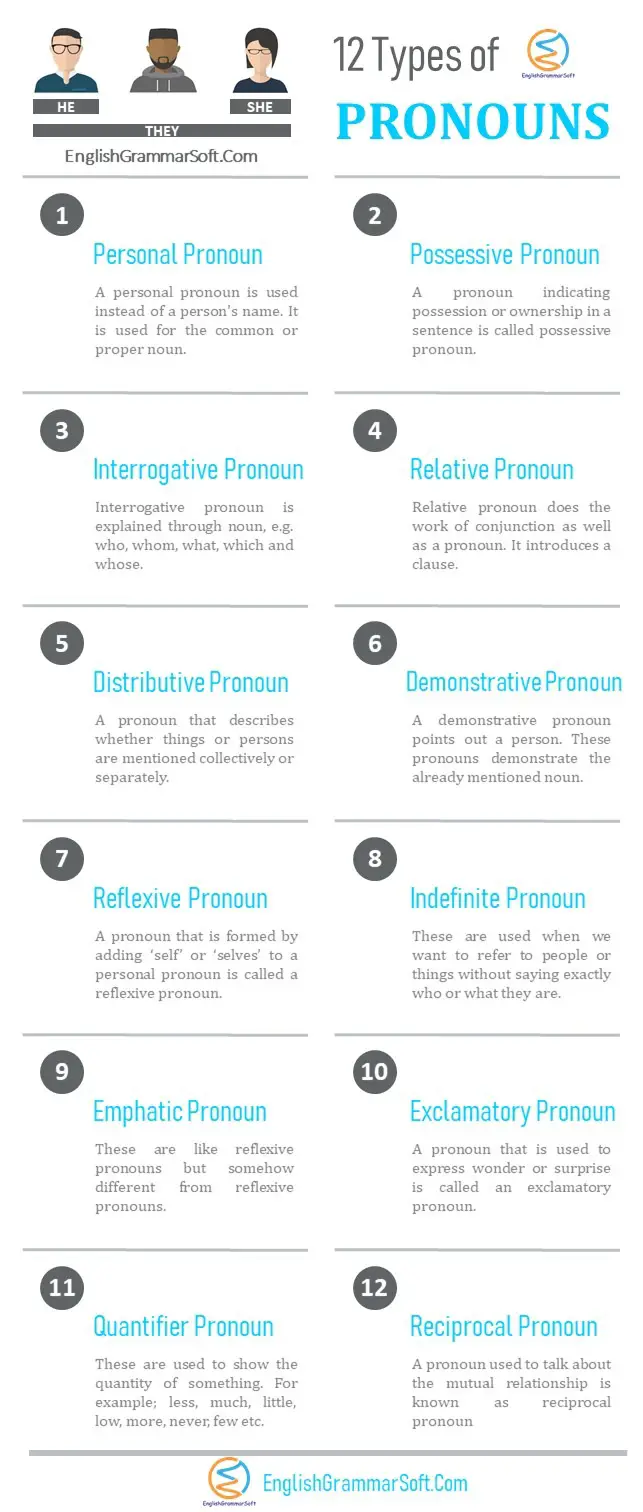

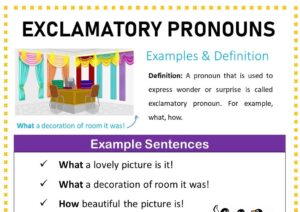

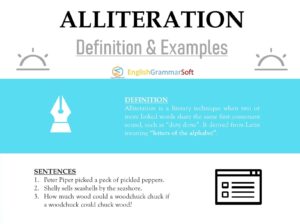

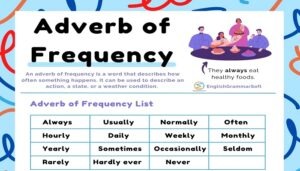
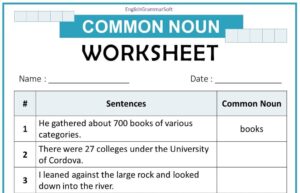

thanks alot